Newcastle Bus Stations
Newcastle Bus Stations - Part One
When I started driving buses, Newcastle had three bus Stations, Haymarket, Marlborough Crescent and Worswick Street. That was in 1967, Eldon Square came later, and as far as I can remember Gallowgate was at that time a United depot/workshops, which after the creation of NBC became the start point for long distance services. There were exceptions, but as a rough rule of thumb, routes to North West Durham, Cumberland and Westmoreland left from Marlborough Crescent, anything south of the Tyne went from Worswick Street and services heading north or east left from Haymarket.
Marlborough Crescent
Dating from the 1920's, Marlborough Crescent was the oldest of Newcastle's bus stations. Triangular in shape, the three roads that formed the border were Marlborough Crescent, Westmoreland Road, and Scotswood Road, as in 'Gannin Alang The' in the chorus of the Geordie Anthem Blaydon Races. At first, it was little more than an open space with a few numbered areas set aside for buses to pick up passengers. In general, services from here went to North West Durham, Cumberland, Westmoreland, and all points west along the Tyne Valley including Carlisle. Hall brothers of South Shields were a notable exception to the rule as they served the Midlands. In the 1960's Hall bought Taylor Bros of North Shields, then subsequently became part of the Barton Group. Routes to the Stanley and Consett area were mostly NGT and Venture; services along the Tyne Valley and as far as Carlisle were United. OK Motor Services ran to Bishop Auckland, Wright Brothers served Alston and Penrith, and Primrose ran an all year round twice daily service to Blackpool. If memory serves, the Primrose morning departure was quite early, about 08:00 I think, it ran via Bishop Auckland, Barnard Castle, Brough, Kirkby Stephen, Kirkby Lonsdale, Sedburgh, Lancaster, and Garstang, and the running time was about five hours. The afternoon departure from Blackpool was about 15:00, by the time the vehicle got back to Newcastle and then its depot, it had been on the go for about 14 hours, and so two drivers were used. The afternoon departure from Newcastle stayed overnight, and then became the next morning's service from Blackpool, so only one driver was needed. As a point of interest, this was an era when most bus companies were always short of drivers, but vacancies at Primrose were unheard of.
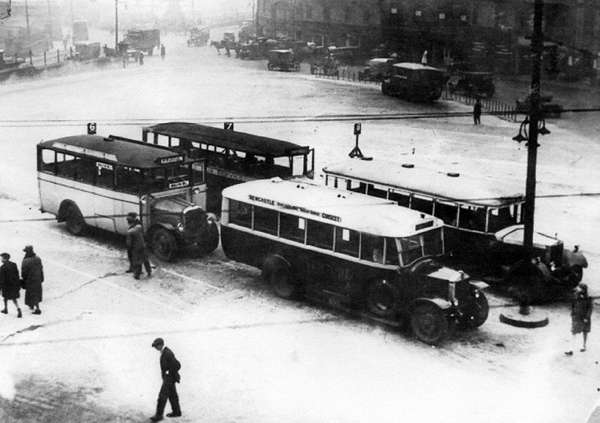
According to Newcastle City Libraries, this is the oldest know photo of Marlborough Crescent bus station, they have it as c1920. The bus in the foreground is an unidentified Venture and probably the one alongside it, but I cant make out enough to have a stab at the other two. The buildings to the right are in the Crescent itself, behind is Scotswood Road, vehicles would exit via Westmoreland Road.

JHN 395; BLO295; a B35R L5G en route to that well-known Tilling Group destination of Duplicate. It may be me, but for some reason the area around the windows looks wrong.
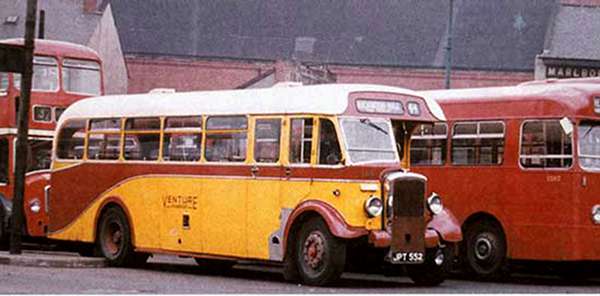
JPT 552; a 1948 Daimler CVD6 with B35F Willowbrook body. One of 60 delivered to Venture between 1946/48. I am aware of one that has survived into preservation JPT 544.

Bound for Leicester. BCU 913; a Burlingham body with no name or badges to identify the chassis, but if the wheel trims are anything to go by its a Bedford SB. Just behind is an unidentified AEC, possibly an MU3RV with C41F Plaxton Venturer body. Sorry, no further details other than the obvious.
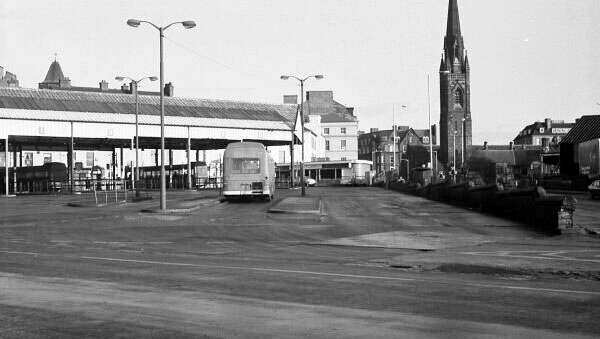
Looking East towards St Mary's Catholic Cathedral in Clayton Street.
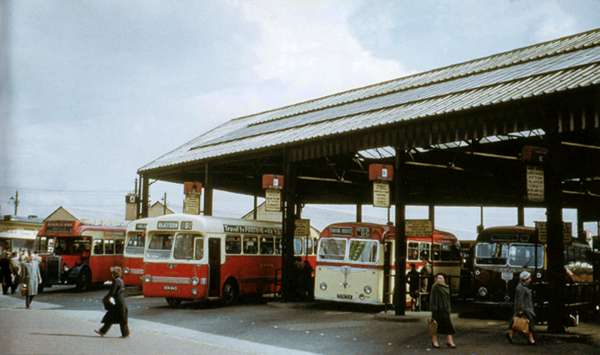
A wonderful 60's line up. A United L bound for Branch End which is near Hexham. A pair of Saunders-Roe bodied Tiger Cubs and a Willowbrook bodied AEC of NGT, completing the line up is a Willowbrook bodied Atkinson Alpha of Venture. The AEC is bound for Quaking Houses, a mining village near Stanley. To the best of my knowledge the area is not especially prone to earth tremors.
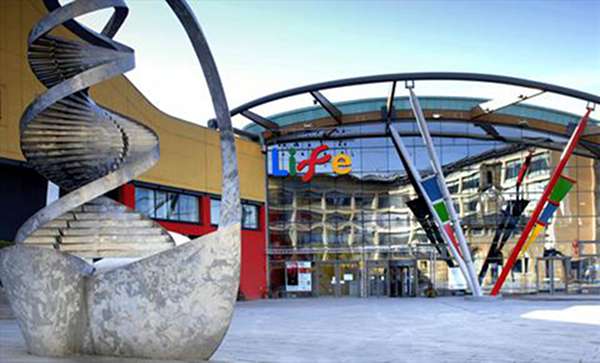
The site of Marlborough Crescent now.
Ronnie Hoye
09/2014
Part Two - Worswick Street Bus Station
05/09/14 - 18:00
Newcastle isn't an area I know well, but it's good to see these images. I think that the Library is a bit early in it's c.1920 suggested date for picture 1, the coaches look more like c.1925/28? Maybe others will identify items to clarify it. The caption for picture 2 suggests that the windows of the Bristol L look "odd". No doubt this is because only the lower fixed portions are radiused, with a squared off separate slider over each one. I believe that this is how ECW built the first batches of buses once the war was over, and it was only later that the window design was modified to include the slider in the whole window, radiused top and bottom. As this modification took place early on, this modification is the style we are all most familiar with and expect to see. Alternatively, both Strachan and Beadle built ECW look-alikes on Bristol L chassis for some Tilling companies, and possibly some of these were to the style illustrated. However, the Beadle design had a distinctive droop to the driver's front windscreen, which the bus shown doesn't have. So, the bus shown is probably either ECW body of the immediate post-war design, or a Strachans look-alike.
Michael Hampton
06/09/14 - 07:30
To amplify Michael's comments about the ECW bodies, I believe the design change was associated with the change from timber to alloy framing. The early postwar ECW bodies with timber frames seem to have been much less durable and as a consequence they tended to have shorter lives than the alloy-bodied examples. This combined with much greater numbers of the alloy design and the simple fact that they were slightly later means that for most of us the predominant experience has been of the later design.
David Beilby
06/09/14 - 07:30
A fascinating article and set of photographs, Ronnie.
In the oldest photograph, I'm pretty sure that the bus nearest the camera is an Albion belonging to Reed Bros of Sunniside. In 1925, they joined forces with Messrs Harrison & Richardson, who were already using the 'Venture' name, to operate between Newcastle and Shotley Bridge whereafter the service was extended to Consett. As the bus is clearly displaying 'Consett' on its roofboard, this would date the photograph to no earlier than 1925. The bus alongside it looks like one of Annie Bessford's Leyland Lionesses, new in 1927, which, if I'm right, would date the photograph to even later. Mrs Bessford, from High Spen, operated between High Spen and Newcastle via Rowlands Gill and her business was acquired by Robson Bros - by then a Venture subsidiary - in 1934. The other two have me stumped although the style of fleetname on the bus farthest away (beside the stand 7 'dolly') is reminiscent of that used by Clydesdale's Bus Service of Chopwell who operated between that village and Newcastle via Ryton and which came into the Venture fold in 1934.
In the second photo, BLO295 was ECW B35R-bodied and was new in 1948. Under the 1951 renumbering exercise, it became BG309 so, if the earlier fleetnumber can be seen in the photo, it would date that shot to the 1948-1951 period.
In the next photograph, Venture 164, JPT 552, was one of six (160-165) to have restyled cabs to enable the company to introduce OMO in 1959: the cream roofs were also introduced in 1959. I've seen this photograph elsewhere dated 1963.
In the final 'old' photo, Branch End is between Mickley Square and Stocksfield and achieved a notoriety of sorts when Alan Whicker presented a report for the 'Tonight' programme which made fun of the fact that some of the house numbers don't run in a logical order.
The origin of the name Quaking Houses (Quakies, as it's invariably known) has been disputed for generations. The village was originally called Old South Moor and the most likely origin of the name is that there was a hill to the North West of the current village called Quaking Hill with a Quaking House farm and Quaking House Cottages nearby. South Moor Colliery (Quaking House pit), originally the New Shield Row pit and latterly the Charley pit, was sunk on this hill in 1845. Less likely is the tale that a Quaker lived close to the site of the William pit at the other end of the village. Equally unlikely is the theory that an underground waggonway caused the houses to vibrate.
Marlborough wasn't endowed with much by way of facilities but it had character; unfortunately, its situation, well away from the centre of the city, particularly after that centre became primarily concentrated on the Eldon Square and Northumberland Street areas, made it increasingly inconvenient.
Alan R Hall
08/09/14 - 16:00
The window area of the United Bristol L-type is not wrong. This style of window was standard for the first year or so of production of the standard ECW body, and could also be found on contemporary K-types. Many Tilling Fleets took delivery of a few of this variant before the more familiar style was adopted.
Don McKeown
09/09/14 - 06:30
The first theory about "Quaking House" may be near the mark, Alan, as these "Dissenters'" meeting houses had to be hidden away from the towns. There is a lovely and discreet hamlet called "Quaker Bottom" on the Huddersfield/Sheffield Road, not far south of Lepton - and County Motors! It has a Meeting House.
Joe
09/09/14 - 18:00
The North East was one of the main stamping grounds of the Quakers (Society of Friends), so the name connection with Quaking Houses is quite likely. I believe they were quite influential in the origins of the North Eastern Railway, for example.
Stephen Ford
Comments regarding the above are more than welcome please get in touch via the 'Contact Page' or by email at obp-admin@nwframpton.com
If you have any bus related photographs that you would like to appear in a gallery on this website please send them to me by email at obp-admin@nwframpton.com
All rights to the design and layout of this website are reserved
Old Bus Photos from Saturday 25th April 2009 to Wednesday 3rd January 2024